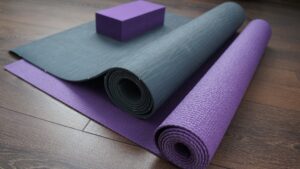Hello dancers! It looks like you’ve found your way to the final article in my series all about snapping hip syndrome! If you’ve read the other two articles (the best stretches and strengthening exercises for snapping hip syndrome) then you’ve probably already got a fairly good idea about what snapping hip syndrome actually is (feel free to skip the next few paragraphs and crack straight on with the exercises). However, if you’re a newbie to this series, then carry on reading to learn more about the condition, including how we can use foam rolling for snapping hip syndrome treatment in dancers!
Ballet dancers are constantly turning out their feet and lifting their legs to impressive heights, however doing so can lead to the IT band and iliopsoas tendon (a.k.a the main hip flexor) becoming super tight, which is a recipe for developing snapping hip syndrome. Without the proper strength training, dancers can suffer from weak hip flexors, glutes and core, which can increase tightness and strain in the muscles surrounding the hip, further contributing to the development of the condition.
There are three types of snapping hip syndrome (internal, external and intra-articular), however dancers tend to suffer more from the former two. External snapping hip syndrome occurs when the IT band moves over the greater trochanter, and you are most likely to experience this as a snapping sensation on the outside of your hip when walking, or during extensions a la seconde and rond de jamb en l’air. Internal snapping hip is usually described as a popping in your groin or on the inside of your hip, and is caused by the iliopsoas tendon sliding against the lesser trochanter. Look out for this popping sensation when lowering the leg from devant extensions.
Although there isn’t a great deal of evidence to prove whether foam rolling really works or not, it’s becoming more and more common in the dance industry for achieving myofascial release -or the release of tight muscles. Since foam rolling helps to relax our muscles and increase blood flow to the area, you should always foam roll before you start stretching to help increase flexibility (even though the results may only be short term).
When you find a sore spot or ‘trigger point’, hold the position and let gravity take your weight so that the foam roller can push deeper into the problem area. This will help to release muscle knots, which are often caused by repetitive movement. It’s no secret that foam rolling can be painful, however as a ballerina it’s important that you learn to listen to your body. This means always knowing when to stop if the pain gets too much!
In this series of articles, I’ve let you in on my secrets to combat snapping hip syndrome through strengthening, stretching and foam rolling. However, if you suspect that you may be suffering from the condition, make sure that you seek a diagnosis from a doctor or physiotherapist before engaging in any of these exercises!
…And that’s the boring bit with over with! Keep reading for the best foam rolling exercises to combat snapping hip syndrome in dancers…

Exercise #1 – quad foam rolling
If you’re suffering from snapping hip syndrome, you may have noticed tightness in your quads. In some cases, tight quads may be responsible for the misalignment of the hips into an anterior pelvic tilt position (forward tilting of the pelvis) should they tug on the hip flexors.
This misalignment can exacerbate snapping hip syndrome, particularly in dancers who are continually turning out and performing leg extensions. Tight quads may also be a sign of muscular imbalance and weakness in the posterior chain (the glutes and hamstrings), which can also lead to the condition.
Step 1 – Place your foam roller horizontally underneath your quad. The leg you are foam rolling should be extended straight out behind you. You can bend your other leg out to the side and rest it on the floor for stability
Step 2 – Using your forearms, slowly roll your quad back and forth over the foam roller
Step 3 – Repeat on the other side
Foam rolling tight quads (or any tight muscle in general) can be very painful. If this is the case, try taking some of your weight onto your forearms or your relaxed leg.
Exercise #2 – IT band roll
A tight IT band is a major cause of external snapping hip syndrome. Dancers who haven’t been able to access the correct strength training are more likely to ‘grip’ their quads and use the TFL muscle during turn out and leg extensions, instead of the external rotators, iliopsoas and core. This overuse of the TFL can lead to tightness and pulling on the IT band. A tight IT band may snap over the greater trochanter of the hip (external snapping hip syndrome).
Step 1 – Place your foam roller horizontally under your IT band (the outside of your thigh). Your forearm should take your weight, and you should cross your other leg over for stability
Step 2 – Gently roll up and down over the foam roller
Step 3 – Repeat on the other side
Too easy? To allow the foam roller to get deeper into the fascia to reduce tightness in the muscle, you will need to place more weight on it. Do this by placing your supporting leg on top of the leg you are rolling.
Exercise #3 – hip flexor rolling
Dancers spend most of their time turning out and lifting their legs, however doing so can lead to internal snapping hip syndrome. That’s because external rotation and hip flexion can cause tightness of the iliopsoas, causing it to snap over the lesser trochanter. Foam rolling is a great way of decreasing tightness in the iliopsoas, helping it to glide over the lesser trochanter easily without that painful snapping!
Step 1 – Place the foam roller horizontally underneath your iliopsoas (near the front of your hip and groin area). Use your forearms to hold your weight and your supporting leg to stabilise yourself
Step 2 – Roll back and forth over the foam roller
Step 3 – Repeat on the other side
Exercise #4 – adductor rolling
Dancers often forget about the adductors, but we actually use them all the time! Any movements which require the legs to move together or towards the midline of the body, for example assemblé and brisé, are executed using the adductor muscles. One of other main functions of the adductors is to stabilise the hips. This means that if the adductors are tight the pelvis can become misaligned, potentially contributing to snapping hip syndrome or hip pain in general.
Step 1 – Lie down on your front and bend your left leg out to the side in a ‘frog position’
Step 2 – Take your weight on your forearms and lift your torso off the floor
Step 3 – Place the foam roller vertically underneath the inner thigh of your left leg. Push up onto the toes of the straightened leg so that your body in no longer touching the floor
Step 4 – Use your right leg and hip to manoeuvre yourself from side to side, sliding over the foam roller as you do so
Step 5 – Repeat on the other side
Exercise #5 – gluteus medius roll
Another well known muscle to ballerinas is the gluteus medius. Located in the outer/upper regions of your glutes, the gluteus medius is not only used for hip stabilisation, but hip abduction (moving the legs away from the midline of the body) and internal rotation. Overuse of the gluteus medius can easily occur in dancers, which can be especially problematic since the muscle is connected to the IT band. This means that if the gluteus medius is tight, it can pull on the IT band leading to tightness of the fascia and snapping hip syndrome.
Step 1 – Place your foam roller horizontally and sit on it, extending your left leg out in front of you whilst keeping your right leg bent. Your right foot should be on the floor for stability
Step 2 – Tilt slightly towards your left leg so that the foam roller is positioned underneath your gluteus medius. You can place your left hand on the floor behind the foam roller for balance
Step 3 – Gently rock back and forth over the foam roller
Step 4 – Repeat on the other side
Exercise #6 – supine iliopsoas stretch
After all that rolling it’s time for a stretch – using the foam roller of course! During hip flexion, the iliopsoas contracts as we bring our knee towards our chest. This means that extending the leg backwards, for example in arabesque, lengthens the iliopsoas and allows it to stretch. We can create a similar stretch using a foam roller, which will help to reduce tightness in the hip flexors and prevent snapping hip syndrome!
Step 1 – Lie down on your back and place the foam roller horizontally underneath your sacrum. Try to relax your body so that your shoulders and feet remain on the floor
Step 2 – Bend your right leg and use your hands to bring your thigh towards your chest
Step 3 – Hold the position for 30 seconds
Step 4 – Repeat on the other side
Using a foam roller creatively in your flexibility routine can be super helpful for dancers looking to push further into a static position for a deeper stretch. But remember… always stretch responsibly and STOP if you experience pain!
Final thoughts of Foam Rolling for Snapping Hip Syndrome in Dancers
…And that’s a wrap! If you’ve managed to make it this far, then you’re now armed with some of the best foam rolling exercises to combat snapping hip syndrome for dancers! Wanting more? Since the key to overcoming snapping hip syndrome is a combination of stretching and strengthening, if you haven’t already done so, I’d highly recommend checking out my other articles in the snapping hip syndrome series (Snapping Hip Syndrome Exercises for Dancers – Strengthening Edition and The Best Snapping Hip Syndrome Stretches for Dancers) for all the information you need to wave goodbye to that painful snapping for good!
**FRIENDLY DISCLAIMER: All information, guidance or advice provided on this site is for informational and educational purposes only. The use of this information is at your own risk.**

